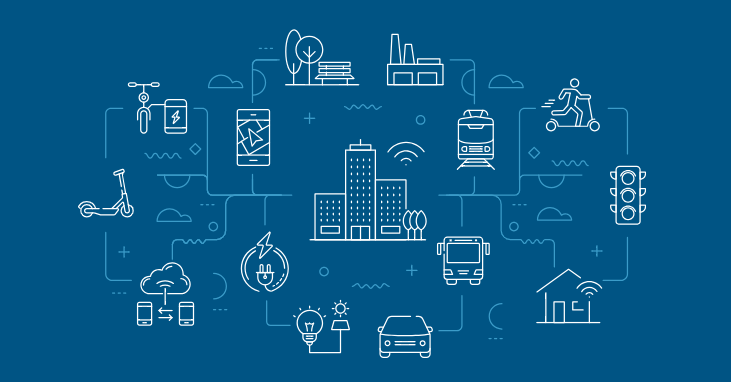The Internet of Things refers to the collective network of connected devices and the technology that makes communication between devices and the cloud – or between devices themselves – possible.
The ways the Internet of Things can be used in transit are limitless. Imagine the power of having every aspect of your transit system — and every user, from riders to maintenance staff to administrators – connected by compatible hardware and software.
It may sound futuristic, but chances are you’re already using it at work and at home. Do you have a video doorbell, a smart thermostat, or a washer and dryer that sends a notification to your phone when it’s time to change the laundry over? Is there a tracking tile attached to your keys or your dog’s collar? If so, you are already using the Internet of Things (IoT).
7 benefits of an IoT system for transit
The technology that enables the Internet of Things has been around since the 90s, but until the last decade or so, the chips used for it were too bulky, slow, and expensive for widespread use. Today, IoT is everywhere and used every day — at home, at work, and in public. Fare collection for public transit is no exception.
The Internet of Things has potential for our industry that we’re just now realizing. The technology it requires is readily available; we just need to catch up in learning how to make the most of it. Some of the many benefits that IoT empowers in public transit include:
- More informed data-driven decision making such as route optimization and ridership outreach
- Prediction of outcomes for proactive service such as maintenance of hardware or vaulting scheduling
- Identification of new opportunities such as targeted fare structures for students or seniors or organizational partnerships with institutions and employers
- Distributed and controlled access to cloud-based data across users and devices
- Monitoring of infrastructure and asset tracking for safety, security, and efficiency
- Remote installation of software updates, fare structures, and security patches
- Future-proofing to embrace new technologies without disrupting the current systems
How the Internet of Things connects all things transit
Just about every aspect of transit operations and administration can be enhanced by the Internet of Things, and its benefits can extend to every role.
Interoperability
Today’s riders have more choices than ever for the first and last miles of their commute. For example, they could hail a ride share, rent a bike or scooter share, or park and ride. Although these services are typically provided by different companies, APIs provide the opportunity for a rider to plan their trip or even pay for it across modalities. Imagine the convenience to a rider who can pre-pay for their parking, know exactly then the bus arrives, and how many bikes are available near their bus stop on the same app they use to purchase fares.
Interoperability also applies to neighboring or overlapping transit systems. For example, Genfare customer Pace Suburban Bus shares a smart card system and trip planning data with the Chicago Transit Authority and the Metra commuter rail system, even though all three systems have different fare collection hardware and software.
Flexible fare structures
In the past, fare structures took a lot of effort to change and required marketing campaigns to help riders understand them so they could board with the right amount of cash or have the right tokens or magnetic cards. Today, APIs make it easy to push new fare structures to fareboxes and validators; enable fare capping using smart cards, open payment, or mobile apps; and even offer short-term promotions such as free rides or round-trip discounts on specific routes for events. Riders and operators don’t even have to think about the fares because flexible structures are easy to implement across payment methods.
Organizational partnerships
The Internet of Things simplifies partnerships between organizations and transit agencies. This allows the schools, employers, social service agencies, or healthcare providers to not just manage fare payment for riders associated with their organizations, but also to get creative about fare payment. For example, APIs make it possible for schools to manage student fares, and students to pay with their physical or digital school IDs, and parents to monitor and reload their children’s accounts online. Or a hospital could discharge a patient from the emergency room with a printed bar code good only for rides originating near the facility within a set number of hours, and the farebox will have the information it needs to validate the fare by the time the rider boards.
Dispatch and tracking
Computer aided dispatch (CAD) provides communication between bus operators and dispatch and automatic vehicle location (AVL) tracks the locations of vehicles. When the CAD/AVL system is connected with systems such as trip planning apps, public-facing websites, municipality construction and emergency closure databases, and fare collection solutions, real-time communication and robust data integration provide valuable real-time and aggregated information to riders and administrators alike.
Maintenance and asset management
The Internet of Things can monitor hardware to identify potential problems and troubleshoot – often before anyone realizes there’s an issue. Alerts can be set to let garage staff know when a farebox needs to be vaulted, a printer head or belt is nearing replacement, or a component isn’t working before the bus returns to the depot. It can also be tasked with tracking events that may indicate a maintenance or operator training issue, such as excessive overrides or bypasses, then troubleshoot accordingly and notify the appropriate staff. The possibilities are endless.
Reporting
A cloud-based reporting platform like Genfare Link® gathers, integrates, and organizes data from across devices and systems to give transit agencies clear insights into their system. It enables staff to access this data and customize and automate reporting, reducing time and effort and centralizing operations to remove silos.
How an IoT system works
 The cornerstone of IoT is the real-time exchange of data. This typically involves three components:
The cornerstone of IoT is the real-time exchange of data. This typically involves three components:
- Smart devices. A smart device is simply hardware that has been given computing abilities. This typically means it collects data and communicates it over the internet to and from its IoT application. In the case of transit, smart hardware includes fareboxes, ticket vending machines, validators, and other devices.
- Application. An IoT application is a collection of services and software that collects and uses data from the smart devices in its system. IoT applications are growing more sophisticated, not just integrating data, but also using machine learning or artificial intelligence to respond to the data. A transit agency’s fare collection software platform performs this function.
- User interface. While often thought of as part of the application, the graphical user interface is the part of system that users interact with on a computer, tablet, or smartphone. This is typically a mobile application or a website. Examples of rider-facing user interfaces are Mobile Link and e-Fare.
Genfare Link serves as both application (performing the functions you don’t see) and user interface (performing the functions you do see).
APIs enable the IoT. An Application Programming Interface (API) is language in software that allows software and smart hardware to communicate within and across platforms. The function of APIs you may be most familiar with is integration, which automatically updates data across systems. For example, when a rider pays their fare using the agency’s mobile application at the farebox, that transaction is quickly reflected in Genfare Link’s data feed and the rider’s account interface. This works whether the agency uses Genfare’s Mobile Link application or another company’s, thanks to APIs.
In essence, the role of the API is to provide a set of definitions and protocols that help the client (the application sending the request) and the server (the application responding to the request) talk to each other.
Genfare Link connects the dots
Genfare Link has been reimagined from the ground up as a cloud-based, one-stop shop fare collection platform. As a centralized back office including dynamic reporting dashboards and real-time maintenance monitoring, Genfare Link is the only platform agencies need.
The new Genfare Link is seamless, from initial integration to ongoing updates and can integrate with any smart hardware or third-party software. It supports all types of fare media available and will flex as technology evolves and new ways to pay are introduced. Its cloud-based, open design makes it a timeless solution for your fare collection operations and security management.
Genfare Link has the power to create dynamic environments where data-driven decision making helps transit agencies adapt more quickly to changes in the community, technology, or regulatory landscape. Whether you’re looking at the big picture or drilling down to granular data, Genfare Link supports your role. Users across the agency can be given access to the functions they need, and not the functions they don’t.
Learn more about how Genfare Link can support your transit agency’s specific needs by contacting your Business Development Director.
